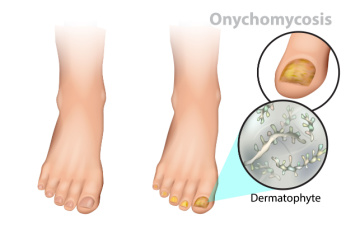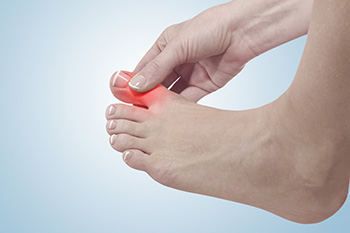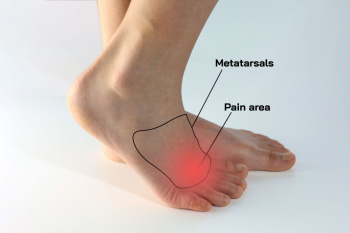Items filtered by date: September 2024
Understanding Toenail Fungal Infections in Children

Fungal toenail infections in kids, also known as onychomycosis, occur when fungi grow in or under the nail, leading to discoloration, thickening, and brittleness. These infections thrive in warm and moist environments, making locker rooms, public pools, and tight-fitting shoes common sources of exposure. Children with weakened immune systems or those prone to athlete’s foot are more susceptible to fungal infections. If your child develops a fungal toenail infection, maintaining proper foot hygiene is essential. Keep their feet clean and dry, and ensure they wear breathable shoes and change socks regularly. If your child’s toenail becomes painful or if multiple nails are affected, it is suggested that you consult a podiatrist.
If left untreated, toenail fungus may spread to other toenails, skin, or even fingernails. If you suspect you have toenail fungus it is important to seek treatment right away. For more information about treatment, contact one of our podiatrists of Florida. Our doctors can provide the care you need to keep you pain-free and on your feet.
Symptoms
- Warped or oddly shaped nails
- Yellowish nails
- Loose/separated nail
- Buildup of bits and pieces of nail fragments under the nail
- Brittle, broken, thickened nail
Treatment
If self-care strategies and over-the-counter medications does not help your fungus, your podiatrist may give you a prescription drug instead. Even if you find relief from your toenail fungus symptoms, you may experience a repeat infection in the future.
Prevention
In order to prevent getting toenail fungus in the future, you should always make sure to wash your feet with soap and water. After washing, it is important to dry your feet thoroughly especially in between the toes. When trimming your toenails, be sure to trim straight across instead of in a rounded shape. It is crucial not to cover up discolored nails with nail polish because that will prevent your nail from being able to “breathe”.
In some cases, surgical procedure may be needed to remove the toenail fungus. Consult with your podiatrist about the best treatment options for your case of toenail fungus.
If you have any questions, please feel free to contact our offices located in North Miami, and Pembroke Pines, FL . We offer the newest diagnostic and treatment technologies for all your foot care needs.
What Is Hallux Rigidus?

Hallux rigidus is a form of arthritis that affects the big toe joint, leading to stiffness and pain. It occurs when the cartilage in the big toe deteriorates, restricting movement and causing discomfort. Early symptoms include pain and swelling at the base of the big toe, particularly during activities like walking or bending the toe. As the condition progresses, the joint becomes increasingly rigid, making it difficult to move the toe and potentially leading to complications, such as altered gait and additional strain on other joints. Hallux rigidus can affect anyone but is more common in middle-aged individuals and those with a family history of arthritis or previous foot injuries. Diagnosis typically involves a physical examination and imaging tests like X-rays to assess joint damage and bone changes. If you are experiencing persistent big toe pain, it is suggested you schedule an appointment with a podiatrist who can provide a comprehensive evaluation and effective treatment options.
Toe pain can disrupt your daily activities. If you have any concerns, contact one of our podiatrists of Florida. Our doctors can provide the care you need to keep you pain-free and on your feet.
What Causes Toe Pain?
Most severe toe pain is caused due to a sports injury, trauma from dropping something heavy on the toe, or bumping into something rigid. Other problems can develop over time for various reasons.
Toe pain can be caused by one or more ailments. The most common include:
- Trauma
- Sports injury
- Wearing shoes that are too tight
- Arthritis
- Gout
- Corns and calluses
- Hammertoe
- Bunions
- Blisters
- Ingrown toenails
- Sprains
- Fractures (broken bones)
- Dislocations
When to See a Podiatrist
- Severe pain
- Persistent pain that lasts more than a week
- Signs of infection
- Continued swelling
- Pain that prevents walking
Diagnosis
In many cases the cause of toe pain is obvious, but in others, a podiatrist may want to use more advanced methods to determine the problem. These can range from simple visual inspections and sensation tests to X-rays and MRI scans. Prior medical history, family medical history, and any recent physical traumatic events will all be taken into consideration for a proper diagnosis.
Treatment
Treatments for toe pain and injuries vary and may include shoe inserts, padding, taping, medicines, injections, and in some cases, surgery. If you believe that you have broken a toe, please see a podiatrist as soon as possible.
If you have any questions please feel free to contact our offices located in North Miami, and Pembroke Pines, FL . We offer the newest diagnostic tools and technology to treat your foot and ankle needs.
Plantar Warts Can Be Treated!
Symptoms and Risk Factors of Morton’s Neuroma

Morton’s neuroma is a painful condition affecting the foot, characterized by the thickening of the tissue surrounding a nerve leading to the toes. This often results in sharp, burning pain in the ball of the foot, with possible numbness or tingling extending into the toes. Symptoms typically worsen with activity and improve with rest. Several risk factors contribute to Morton’s neuroma, including wearing high-heeled or narrow shoes that compress the toes, engaging in high-impact activities, and having foot deformities such as flat feet or high arches. Women are more frequently affected than men, likely due to footwear choices. Wearing proper footwear, avoiding high heels, and using orthotic inserts can help alleviate symptoms. If you have pain in this part of your foot, it is suggested that you promptly schedule an appointment with a podiatrist who can accurately diagnose and treat Morton’s neuroma.
Morton’s neuroma is a very uncomfortable condition to live with. If you think you have Morton’s neuroma, contact one of our podiatrists of Florida. Our doctors will attend to all of your foot care needs and answer any of your related questions.
Morton’s Neuroma
Morton's neuroma is a painful foot condition that commonly affects the areas between the second and third or third and fourth toe, although other areas of the foot are also susceptible. Morton’s neuroma is caused by an inflamed nerve in the foot that is being squeezed and aggravated by surrounding bones.
What Increases the Chances of Having Morton’s Neuroma?
- Ill-fitting high heels or shoes that add pressure to the toe or foot
- Jogging, running or any sport that involves constant impact to the foot
- Flat feet, bunions, and any other foot deformities
Morton’s neuroma is a very treatable condition. Orthotics and shoe inserts can often be used to alleviate the pain on the forefront of the feet. In more severe cases, corticosteroids can also be prescribed. In order to figure out the best treatment for your neuroma, it’s recommended to seek the care of a podiatrist who can diagnose your condition and provide different treatment options.
If you have any questions, please feel free to contact our offices located in North Miami, and Pembroke Pines, FL . We offer the newest diagnostic and treatment technologies for all your foot care needs.
Benefits of Minimally Invasive Foot and Ankle Surgery

Minimally invasive foot and ankle surgery offers significant benefits compared to traditional open surgery. This approach involves making smaller incisions, which allows surgeons to correct deformities or address injuries with minimal disruption to the surrounding tissues. The reduced trauma to the foot and ankle leads to less postoperative pain, smaller scars, and faster recovery times. One of the major advantages of minimally invasive surgery is the quicker return to normal activities, as patients often experience shorter recovery periods and fewer complications, like infections or wound healing issues. Additionally, this technique minimizes the impact on the patient’s overall foot structure, preserving more of the natural anatomy and reducing the need for extensive rehabilitation. If you are facing the need for foot or ankle surgery, it is suggested that you consult a podiatrist to see if a minimally invasive surgical technique is correct for you.
Foot surgery is sometimes necessary to treat a foot ailment. To learn more, contact one of our podiatrists of Florida. Our doctors will assist you with all of your foot and ankle needs.
When Is Surgery Necessary?
Foot and ankle surgery is generally reserved for cases in which less invasive, conservative procedures have failed to alleviate the problem. Some of the cases in which surgery may be necessary include:
- Removing foot deformities like bunions and bone spurs
- Severe arthritis that has caused bone issues
- Cosmetic reconstruction
What Types of Surgery Are There?
The type of surgery you receive will depend on the nature of the problem you have. Some of the possible surgeries include:
- Bunionectomy for painful bunions
- Surgical fusion for realignment of bones
- Neuropathy decompression surgery to treat nerve damage
Benefits of Surgery
Although surgery is usually a last resort, it can provide more complete pain relief compared to non-surgical methods and may allow you to finally resume full activity.
Surgical techniques have also become increasingly sophisticated. Techniques like endoscopic surgery allow for smaller incisions and faster recovery times.
If you have any questions please feel free to contact our offices located in North Miami, and Pembroke Pines, FL . We offer the newest diagnostic and treatment technologies for all your foot and ankle needs.

